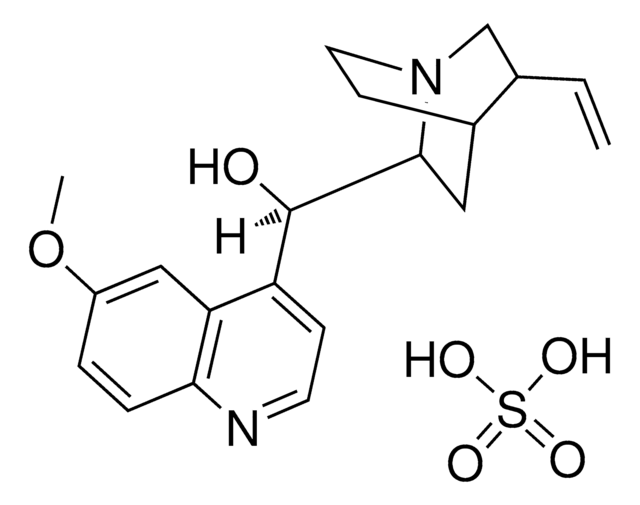Q0132
Quinine sulfate
meets USP testing specifications, monograph mol wt. 782.94 ((C20H24N2O2)2 . H2SO4 . 2H2O)
Synonyme(s) :
Quinine hemisulfate salt monohydrate, Quinine sulfate (2:1) (salt) dihydrate
About This Item
Produits recommandés
Agence
USP/NF
meets USP testing specifications
Poids mol.
monograph mol wt. 782.94
Pf
~225 °C (dec.) (lit.)
Spectre d'activité de l'antibiotique
parasites
Mode d’action
enzyme | inhibits
Chaîne SMILES
O.O.OS(O)(=O)=O.COc1ccc2nccc([C@@H](O)C3CC4CCN3C[C@@H]4C=C)c2c1.COc5ccc6nccc([C@@H](O)C7CC8CCN7C[C@@H]8C=C)c6c5
InChI
1S/2C20H24N2O2.H2O4S.2H2O/c2*1-3-13-12-22-9-7-14(13)10-19(22)20(23)16-6-8-21-18-5-4-15(24-2)11-17(16)18;1-5(2,3)4;;/h2*3-6,8,11,13-14,19-20,23H,1,7,9-10,12H2,2H3;(H2,1,2,3,4);2*1H2/t2*13-,14-,19-,20+;;;/m00.../s1
Clé InChI
ZHNFLHYOFXQIOW-LPYZJUEESA-N
Vous recherchez des produits similaires ? Visite Guide de comparaison des produits
Application
Actions biochimiques/physiologiques
Mention d'avertissement
Warning
Mentions de danger
Conseils de prudence
Classification des risques
Eye Irrit. 2 - Skin Irrit. 2 - STOT SE 3
Organes cibles
Respiratory system
Code de la classe de stockage
11 - Combustible Solids
Classe de danger pour l'eau (WGK)
WGK 3
Point d'éclair (°F)
Not applicable
Point d'éclair (°C)
Not applicable
Équipement de protection individuelle
dust mask type N95 (US), Eyeshields, Gloves
Choose from one of the most recent versions:
Déjà en possession de ce produit ?
Retrouvez la documentation relative aux produits que vous avez récemment achetés dans la Bibliothèque de documents.
Les clients ont également consulté
Notre équipe de scientifiques dispose d'une expérience dans tous les secteurs de la recherche, notamment en sciences de la vie, science des matériaux, synthèse chimique, chromatographie, analyse et dans de nombreux autres domaines..
Contacter notre Service technique







